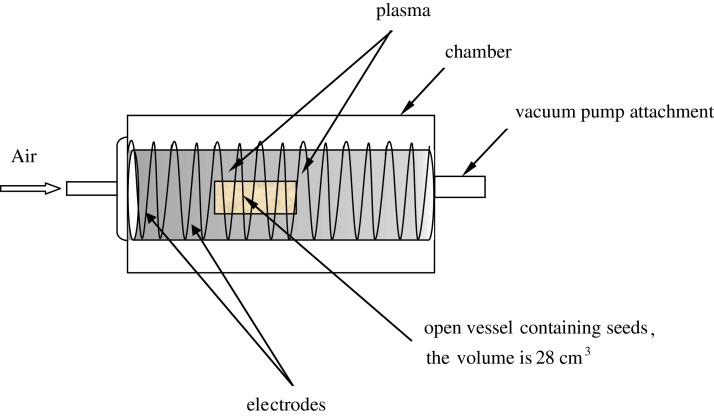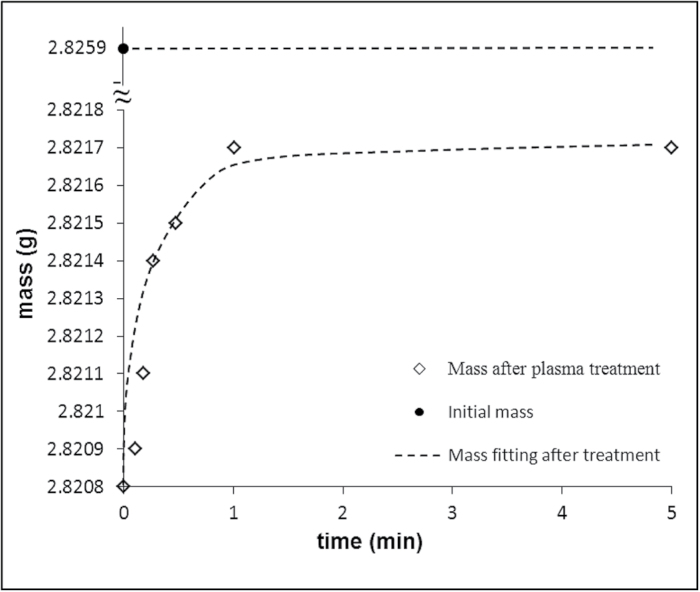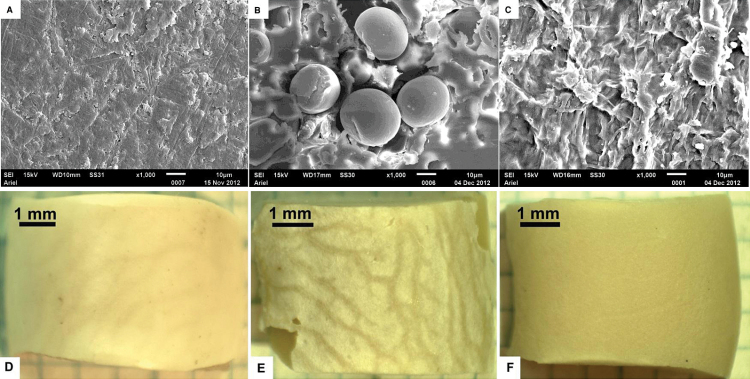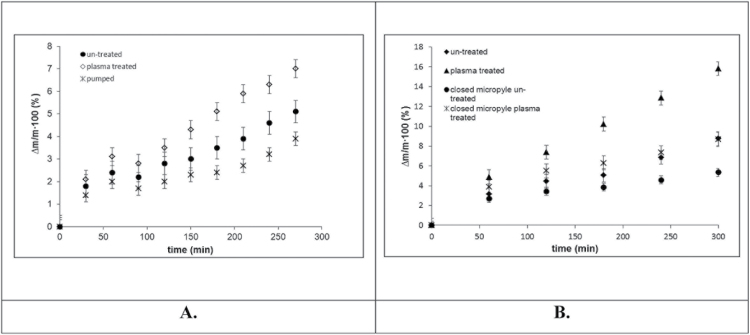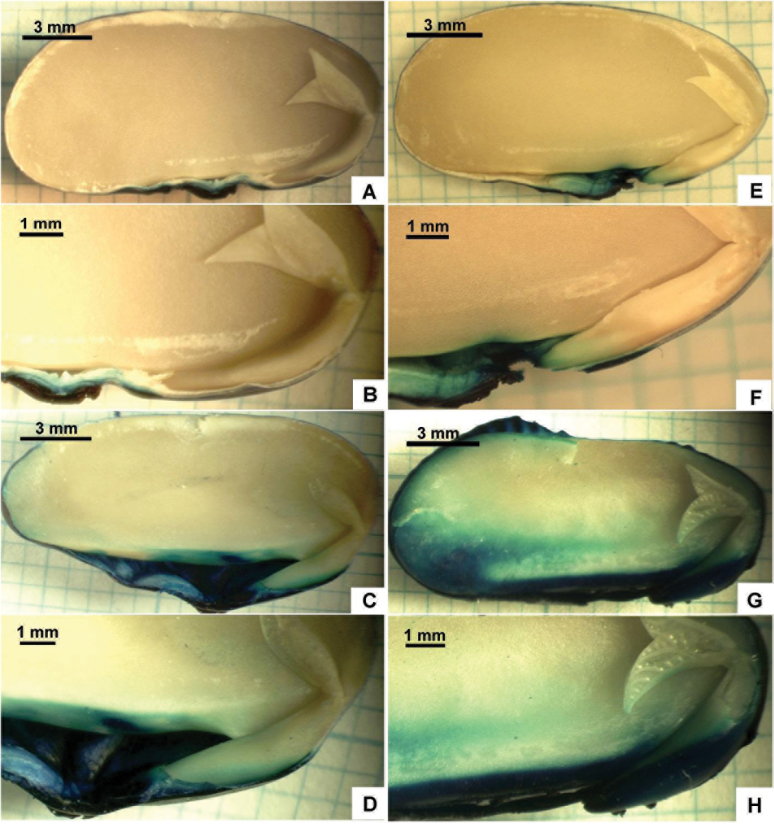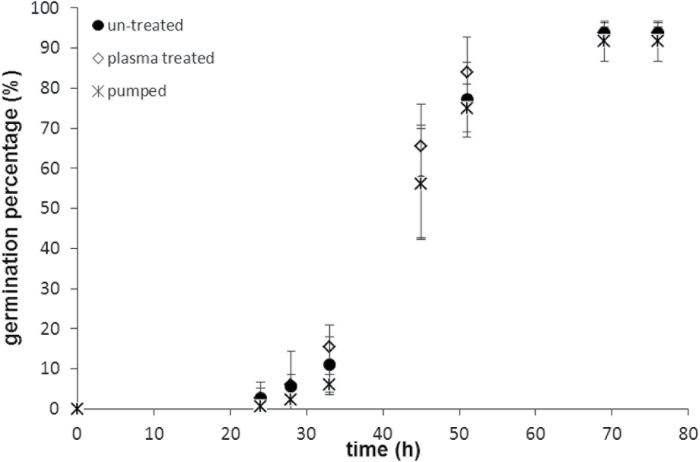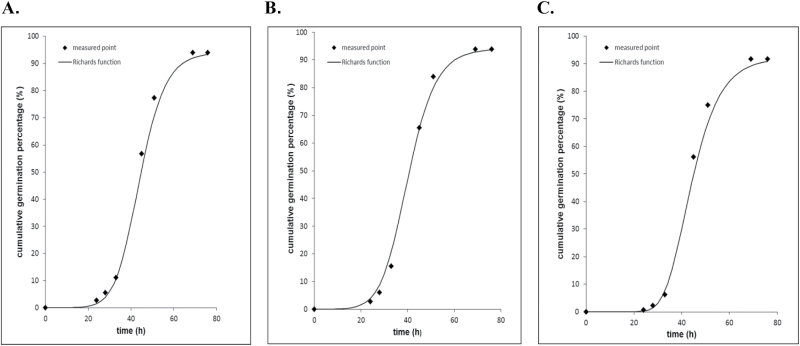Highlight
The impact of cold plasma on the wetting, water absorption, and germination of beans (Phaseolus vulgaris) is reported. Plasma treatment accelerated the water absorption and germination of seeds.
Key words: Beans, contact angle, germination, plasma treatment, water imbibition, wetting properties.
Abstract
The impact of cold radiofrequency air plasma on the wetting properties and water imbibition of beans (Phaseolus vulgaris) was studied. The influence of plasma on wetting of a cotyledon and seed coat (testa) was elucidated. It was established that cold plasma treatment leads to hydrophilization of the cotyledon and tissues constituting the testa when they are separately exposed to plasma. By contrast, when the entire bean is exposed to plasma treatment, only the external surface of the bean is hydrophilized by the cold plasma. Water imbibition by plasma-treated beans was studied. Plasma treatment markedly accelerates the water absorption. The crucial role of a micropyle in the process of water imbibition was established. It was established that the final percentage of germination was almost the same in the cases of plasma-treated, untreated, and vacuum-pumped samples. However, the speed of germination was markedly higher for the plasma-treated samples. The influence of the vacuum pumping involved in the cold plasma treatment on the germination was also clarified.
Introduction
The interaction of various kinds of radiation with plants has been exposed to intensive research (Teramura, 1983; Cen and Bornman, 1990; Jansen et al., 1998; Friesen et al., 2014, Guajardo-Flores et al., 2014). Generally, the researchers focused on the interaction of UV radiation with plants (Cen and Bornman, 1990; Guajardo-Flores et al., 2014). One kind of interaction remains practically uninvestigated, namely the interaction of cold radiofrequency plasma with plants. The first reports in this field appeared only in the last two decades. It seems that the first systematic study of the influence exerted by plasma on seeds was carried out by Volin et al. (2000) who exposed seeds of radish (Raphanus sativus) and two pea cultivars (Pisum sativum cv. ‘Little Marvel’, P. sativum cv. ‘Alaska’) to CF4 and octadecafluorodecalin plasma, and reported a significant delay in germination compared with the untreated controls. Since then, researchers have concentrated on the following main trends of investigation: (i) decontamination of seeds by plasma, (ii) breaking of dormancy with plasma, (iii) the impact of plasma treatment (PT) on germination, and (iv) the impact of PT on root generation (sprouting).
Decontamination and inactivation of pathogenic microorganisms of seeds have been communicated recently by various groups (Selcuk et al., 2008; Filatova et al., 2009; Schnabel et al., 2012). Several groups reported the impact of PT on germination, sprouting, and dormancy breaking of seeds. The experimental data in these fields are scanty and controversial. Sera et al. (2010) investigated the influence of PT on wheat and oat germination. The authors reported that PT did not affect the germination of oat seeds, but they did note accelerated root generation in plants grown from plasma-treated seeds (Sera et al., 2010). The same group also showed that PT did change seed germination in Lamb’s Quarters seeds (Sera et al., 2009). A stimulating effect of cold plasma on both the germination and sprouting of tomato seeds (Lycopersicon esculentum L. Mill. cv. ‘Zhongshu No. 6’) has been reported by Meiqiang et al. (2005). Similar results were reported for Pauwlonia tomentosa seeds (Živković et al., 2004). Kitazaki et al. (2012) studied the growth enhancement of radish sprouts (Raphanus sativus L.) induced by low pressure O2 radiofrequency plasma irradiation. The experimental results revealed that oxygen-related radicals strongly enhance growth, whereas ions and photons do not (Kitazaki et al., 2012). The positive effect of cold helium plasma treatment on seed germination, growth, and yield was reported recently for wheat (Jiafeng et al., 2014). Treatment of spinach seeds by a magnetized arc plasma increased the germination rate by 137% (Shao et al., 2013). It has been demonstrated that cold atmospheric plasma treatment had little effect on the final germination percentage of radish seeds, but it influenced their early growth (Mihai et al., 2014). Generally, the researchers agree that cold plasma treatment is an economical and pollution-free method to improve seed performance and crop yield. It plays essential roles in a broad spectrum of developmental and physiological processes in plants, including reducing the bacterial bearing rate of seeds, changing seed coat structures, increasing the wettability and permeability of seed coats, and stimulating seed germination and seedling growth (Selcuk et al., 2008, Jiafeng et al., 2014; Ling et al. 2014).
Our group recently studied the influence of cold air plasma on lentils (Lens culinaris), beans (Phaseolus vulgaris), and wheat grains (Triticum sp. C9) (Bormashenko et al., 2012). It was established that plasma treatment dramatically influenced the wettability of the seeds, resulting in a significant decrease of the apparent contact angle (de Gennes et al., 2003; Erbil, 2006). The change in wettability is followed by a consequent change in the water imbibition of the seeds. It was also reported that cold PT markedly modifies the wettability of various biological tissues, including lycopodium particles and keratin (Bormashenko and Grynyov, 2012a, b ). The impact of cold plasma on the wettability of keratin has also been reported by Molina et al. (2003).
Hydrophilization of biological tissues by cold plasma resembles the similar effect observed and deeply researched in synthetic polymers (Yasuda, 1976; Strobel et al., 1994; France and Short, 1998; Stoffels et al., 2008).The plasma treatment of synthetic polymers creates a complex mixture of surface functionalities which influence surface physical and chemical properties and results in a dramatic change in the wetting behaviour of the surface (France and Short, 1997; Kaminska et al., 2002). Not only the chemical structure but also the roughness of the surface is affected by the plasma treatment; this also could change the wettability of the surface (Lommatzsch et al., 2007). PT usually strengthens the hydrophilicity of treated synthetic polymer surfaces. However, the surface hydrophilicity created by plasma treatment is often lost over time (Morra et al., 1990). This effect of decreasing hydrophilicity is called ‘hydrophobic recovery’ (Morra et al., 1990; Occhiello et al., 1992; Kaminska et al., 2002; Pascual et al., 2008; Mortazavi et al., 2012). By contrast, in our recent research, hydrophobic recovery was not observed in plasma-treated seeds (Bormashenko et al., 2012). It should be emphasized that cold plasma treatment only influences the nano-scaled external layer of a tissue (France and Short, 1997; Kaminska et al., 2002; Mortazavi and Nosonovsky, 2012; Bormashenko et al., 2013). This fact may be crucial for the biological applications of cold plasma treatment.
There are still many open issues with regard to the mechanisms of plasma action on synthetic polymers. Obviously, the processes of interaction with biological objects such as seeds are even more complicated. In this paper, the focus is on the modification of wetting properties by plasma, studied for a variety of interfaces constituting beans (exotesta, mesotesta, and cotyledon), change in water imbibition due to the plasma treatment, and also on the effect of plasma treatment on the germination of beans. It is noteworthy that beans are amenable for the goniometric study of the effect of plasma on their wettability represented by an apparent contact angle due to their large surface area. Changes in the water imbibition pathways due to the plasma treatment were also tracked, as well as the effect of plasma treatment on the germination kinetics of beans. Our research demonstrates that the speed of germination may be affected by the cold plasma treatment.
Materials and methods
Plasma treatment of beans
PT was carried out with the plasma unit EQ-PDC-326, manufactured by MTI Co, USA. Beans (Phaseolus vulgaris) were exposed to an inductive air plasma discharge under the following parameters: the plasma frequency was on the order of 10 MHz, the power was 20W, the pressure was 6.7×10–2 Pa; the volume of the discharge chamber was 840cm3. The time span of irradiation was 2min. The scheme of the experimental unit used for plasma treatment of the seeds is depicted in Fig. 1. Under plasma treatment, the beans were exposed to low vacuum; hence it was necessary to study separately the impact of a vacuum on the properties of beans.
Fig. 1.
Plasma unit used for treatment of seeds.
Study of the impact of vacuum pumping on the properties of beans
Beans were exposed to a low vacuum with the pressure of 6.7×10–2 Pa for 3min. Ten beans were weighed before and immediately after vacuum pumping. The weight was taken with a MRCASB-220-C2 five place analytical balance. Thus, any weight loss of beans occurring under vacuum pumping was established. Afterwards, the vacuumed beans were exposed to ambient conditions: the average temperature was 22.3 °C; the relative humidity was 31–33%. The weight of the beans was measured continuously over 5min. Thus, the kinetics of water adsorption by the beans was established.
SEM imaging of beans
Irradiated and non-irradiated beans and tissues (a cotyledon and seed coat) were imaged by high resolution SEM (JSM-6510 LV).
Trinocular imaging of beans
Irradiated and non-irradiated beans and tissues constituting the seed were imaged by the trinocular microscope (Model SZM-2) with a USB digital camera (OPTIKAM PRO3) supplied by Optika Microscopes Italy.
Study of the wetting properties of tissues
The wetting properties of tissues were established using a Ramé–Hart goniometer (model 500). Ten measurements were taken to calculate the mean apparent contact angles (de Gennes et al., 2003; Erbil, 2006) for all kinds of studied tissues.
Study of water imbibition
For the study of the time dependence of water absorption (imbibition) by irradiated and non-irradiated beans, 10 seeds were placed on humid blotting paper at ambient conditions; the temperature was 24 °C. Beans were weighed every hour with an MRC ASB-220-C2 analytical balance. The relative water imbibition (absorption) was defined as: , where m 0 is the total initial mass of seeds, and m(t) is the running total mass of seeds. A series of six experiments was performed for untreated, vacuumed (pumped), and plasma-treated beans.
Study of the role of a micropyle in water imbibition
For the study of the role of the micropyle in water imbibition, experiments with open and sealed micropyles were performed. The micropyle was sealed with thermosetting glue (UHU 41686 Instant Super Glue).
Direct visualization of the water penetration
Untreated and plasma-treated beans were immersed in water coloured with Bromophenol Blue (0.33 wt.%) for 5h. Bromophenol blue (3′,3″,5′,5″-tetrabromophenol sulphonphthalein) was supplied by Sigma Aldrich, Israel.
Study of impact of the PT on beans’ germination
For the study of the impact of PT on germination, 30 seeds of irradiated, vacuum-pumped, and non-radiated beans were placed on humid blotting paper for about 80h at constant conditions provided by a growth chamber (Model PGI-500H, supplied by MRC Ltd, Israel); the temperature was kept at 21 °C; the process included 12h of darkness and 12h of light per day. Every 4–8h the numbers of emerged seedlings were counted. The percentage of germination was calculated after counting seedlings on the fourth day. Two sets of 180 seeds were taken for vacuum and plasma treatments, respectively; the control group also included 180 seeds. All experiments were repeated three times.
The results of the experiments were processed by JMP software (Statistical Discovery, Version 7.0.2).
Results and discussion
Impact of vacuum pumping on the properties of beans
When beans are treated with cold plasma, they are necessarily exposed to a vacuum. They also lose weight when pumped and it is possible that their germination rate would also be changed (the germination of beans will be discussed later). The weight loss and water adsorption of pumped beans were established (see Materials and methods: study of the impact of vacuum pumping on the properties of beans). The average weight loss of pumped beans was established as 0.11% compared with the starting weight. Pumped beans partially restored their weight when exposed to a humid atmosphere (for details see Materials and methods: study of the impact of vacuum pumping on the properties of beans). It is plausible to suggest that this restoration is governed by surface events, i.e. water adsorption to the beans’ surface. The dynamics of water adsorption by pumped beans is illustrated in Fig. 2. First of all, it should be stressed that pumped beans did not restore their initial weight. This means that pumping removes water not only from the surface of beans but also from the beans’ bulk. The time dependence of water adsorption of pumped beans is well fitted by Equation 1.
Fig. 2.
Weight loss of beans (n=10) due to the pumping followed by the increase due to the water adsorption. The size of diamonds denoting experimental points indicates the experimental scattering of the results.
| (1) |
where m(t) is the running mass, is the initial mass established immediately after pumping, t is time, τ is the characteristic time of adsorption and is the resulting mass of adsorbed water. The average characteristic time of adsorption τ was established by fitting of experimental data with Equation 1 as 0.38±0.07min.
Impact of the plasma treatment on the wettability of different biological tissues constituting seeds
It has already been reported that cold radiofrequency PT dramatically changed the wettability of the beans’ seed coat (Bormashenko et al., 2012). A similar change in the wetting of soybeans exposed to cold plasma was reported recently (Ling et al., 2014). PT treatment markedly hydrophilized and irreversibly changed the wetting regime of the external side of the seed coat. It was also important to establish the impact exerted by PT on the wettability of other tissues constituting the seed: the testa, including the exotesta and mesotesta, and the cotyledon epidermis (Aniszewski et al., 2006). For this purpose, two series of experiments were carried out. In the first series, intact beans were exposed to the plasma treatment, as described in the Materials and methods: plasma treatment of beans, and, afterwards, the testa and exotesta were separated from the cotyledon using a scalpel and tweezers. The SEM and trinocular images of the inner (mesotesta)/outer (exotesta) sides of the seed coat and cotyledon surface are presented in Fig. 3A–F (for the experimental details see the Materials and methods: SEM and trinocular imaging of beans).
Fig. 3.
SEM images of: (A) the exotesta, (B) the mesotesta, (C) a cotyledon surface, the scale bars=10 μm. Trinocular images of: (D) the exotesta; (E) the mesotesta; (F) a cotyledon surface.
In the second series, the testa was separated from the cotyledon, and they were individually exposed to the PT, as described in the Materials and methods: Plasma treatment of beans. The wettability of irradiated and non-irradiated tissues was established by the measurement of apparent contact angles (APCAs) as described in the Materials and methods: Study of the wetting properties of tissues. The results of the measurements are summarized in Tables 1 and 2, where is the APCA of the exotesta before PT, is the APCA of the exotesta after PT, is the APCA of the mesotesta before PT, is the APCA of the mesotesta after PT, is the APCA of the cotyledon before PT, and is the APCA of the cotyledon after PT.
Table 1.
Apparent contact angles (in degrees) as established for different tissues for entire beans exposed to PT (subscripts: EXO, exotesta; MESO, mesotesta; COT, cotyledon; superscripts: 0, untreated beans; PT, plasma-treated beans)
|
|
|
|
|
|
|
||||||
|---|---|---|---|---|---|---|---|---|---|---|---|
| 109±1 | 40±1 | 132±1 | 131±2 | 101±2 | 100±2 |
Table 2.
Apparent contact angles (in degrees) as established for different tissues for seed coatings and cotyledons exposed separately to plasma treatment
|
|
|
|
|
|
|
||||||
|---|---|---|---|---|---|---|---|---|---|---|---|
| 109±1 | 40±1 | 132±1 | 0 | 101±2 | 72±1 |
First of all, it should be stressed that the mesotesta demonstrated an apparent contact angle as high as 132°, as depicted in Fig. 4A, which is close to the APCA inherent to superhydrophobic surfaces (Barthlot et al., 1997; Nosonovsky, 2007; Bhushan et al., 2010; Bormashenko et al., 2013). The high values of APCA are due to the multiscale roughness observed on the mesotesta, shown in Fig. 3B (Nosonovsky, 2007). However, the mesotesta does not demonstrate a true superhydrophobicity, but rather the so-called ‘rose petal effect’, where high values of APCA are attended by a high adhesion wetting regime, illustrated in Fig. 4B–D. Indeed, a water droplet remained connected to the mesotesta even in the ‘pendant’ position, as shown in Fig. 4B.
Fig. 4.
The ‘rose petal effect’ observed on the mesotesta of bean seeds. High apparent contact angles are attended by a high adhesive wetting state. The droplet is attached to the surface even in the pendant position.
It should be emphasized that the mesotesta kept its pronounced hydrophobicity when the entire bean was exposed to PT. The APCA did not change, as seen from the data supplied in Table 1. The cold plasma comprises a variety of species, including atoms, ions, electrons, and photons (Lieberman et al., 2005). However, the changes in wettability of organic tissues produced by cold plasma are mainly ascribed to the collisions of ions with moieties constituting a tissue. Indeed, the energy transfer related to collisions of electrons with a tissue is negligible, and the energy of photons is deficient for the essential changes in the wettability of a tissue (Lieberman et al., 2005). Thus, the absence of changes in the wettability of the mesotesta leads to the suggestion that ions lost their energy when penetrating through the coat, and these ions are incapable of modifying the wetting regime of the surface.
It is also seen from data, presented in Table 1, that the wetting properties of the cotyledon were similarly not changed by plasma when entire beans were treated. Thus, the absence of changes in the wettability of the cotyledon strengthens the hypothesis that the plasma species ‘attenuated’ by the coat do not have sufficient energy for the modification of the wettability of the internal sides of the biological surfaces studied in our research. By contrast, cold plasma markedly hydrophilized all the biological surfaces studied when they were separately exposed to PT, as seen from the data presented in Table 2. A jump from pronounced hydrophobicity to complete wetting was observed for the strongly hydrophobic mesotesta. Changes in APCA as high as 69° and 28° were observed for the exotesta and cotyledon. These findings coincide with those reported in our previous work (Bormashenko et al., 2012). It is concluded that PT modifies the wetting of various tissues constituting beans, when the access of ions to the tissues is not restricted.
Study of the water absorption by untreated and plasma-treated beans
As shown in the previous section, PT modifies the wetting regime of tissues and promotes their hydrophilization. This effect leads to increased water absorption (imbibition) of plasma-treated seeds, as demonstrated in our recent paper (Bormashenko et al., 2012). We now report more detailed study of water imbibition by plasma-treated beans, in which the pathways of water imbibition were investigated. The water imbibition occurring in plasma-treated beans is a complicated process, influenced by a number of factors. (i) It was demonstrated in ‘Impact of vacuum pumping on the properties of beans’ that vacuum pumping removes water not only from the surface of beans, but also from their bulk. Thus, it is reasonable to suggest that vacuum pumping will also influence the process of water imbibition. (ii) The seed coating inherent for beans is not intact; it contains a small opening called a ‘micropyle’ (Bewley and Black, 1994). The crucial role of the micropyle in water imbibition is widely acknowledged (Hagon, 1970; Rolston, 1978; Gama-Arachchige et al., 2013).
In order to separate the impact of factors influencing water imbibition, two series of experiments were performed. In the first series, water imbibition of untreated, vacuum-pumped (without plasma), and plasma-treated beans was studied, as described in ‘Study of water imbibition’. In these experiments the micropyle was open. The results of these experiments are depicted in Fig. 5A. It was seen that PT markedly promotes water imbibition. It is also recognized from data supplied in Fig. 5A that vacuum pumping retards water absorption. This observation calls for future investigation.
Fig. 5.
Water absorption by beans. (A) Comparative study of water imbibition by untreated, pumped without plasma, and plasma-treated beans. (B) Comparative study of water imbibition by non-treated beans with an open micropyle, plasma-treated beans with an open micropyle, untreated beans with a closed micropyle, plasma-treated beans with a closed micropyle.
The second series of experiments was intended to reveal the precise role of the micropyle in water imbibition. For this purpose, the micropyle was sealed precisely with a small droplet of glue (for details, see the Material and methods: study of the role of a micropyle in water imbibition). Thus water imbibition by four kinds of beans was studied, namely: untreated beans with an open micropyle, plasma-treated beans with an open micropyle, untreated beans with a sealed micropyle, and plasma-treated beans with a sealed micropyle. Their water imbibition was studied as described in the Materials and methods: study of water imbibition; the results are depicted in Fig. 5B. It is distinctly seen that the fastest water imbibition was observed for plasma-treated beans with an open micropyle. The slowest water absorption was registered for untreated beans with a sealed micropyle. Plasma treated beans with a sealed micropyle demonstrated a speed of water imbibition higher than that of untreated beans with a sealed micropyle, but remarkably slower than that of plasma-treated beans with open (unsealed) micropyles. Thus, the strengthening impact of plasma treatment on water imbibition through the beans’ coat, as well as the essential role of the micropyle, were both established.
Qualitative experiments were also performed which shed light on the kinetics of water imbibition. Untreated and plasma-treated beans were immersed in water coloured with Bromophenol Blue (see the Materials and methods: direct visualization of water penetration), which visualized the process of water penetration into the beans. Immersed beans were cut every hour, and a distinct boundary was observed, separating areas wet by coloured water and non-wet ones, as shown in Fig. 6A–H, where: (A, B) is the untreated bean after 2h in coloured water; (C, D) is the untreated bean after 5h in coloured water; (E, F) is the plasma-treated bean after 2h in coloured water; (G, H) is the plasma-treated bean after 5h in coloured water. It was clearly seen that more rapid penetration occurs in plasma-treated beans. The micropyles in these experiments were open. It can also be recognized from Fig. 6A–H that water penetrates into beans from the side of a micropyle. This further demonstrates the key role of a micropyle in the process of water imbibition (Rolston, 1978; Gama-Arachchige et al., 2013).
Fig. 6.
Trinocular images of water penetration in plasma treated (E–H) and non-treated (A–D) beans. (A, B) untreated bean after 2h in coloured water; (C, D) untreated bean after 5h in coloured water; (E, F) plasma-treated bean after 2h in coloured water; (G, H) plasma-treated bean after 5h in coloured water. Water was coloured with Bromophenol Blue. The micropyle is open.
The impact of PT on beans’ germination
As shown in the previous sections, PT leads to increased water absorption (imbibition) of seeds. It was also important to verify the impact of increased water absorption on the germination process of seeds. For this purpose, three groups of bean seeds were used: one group of seeds was treated by cold plasma, as described in the Materials and methods: Plasma treatment of beans, the second group was treated by vacuum pumping, and the third group of seeds was untreated. No significant difference was observed in viability (the percentage of germination); all three groups of seeds demonstrated the same viability rates, which were about 92–94%, as depicted in Fig. 7.
Fig. 7.
Comparative study of the germination process observed in untreated, vacuum-pumped, and plasma-treated beans.
In order to derive the data describing the kinetics of germination, Richards’curves were fitted to a number of experiments (Richards, 1959; Hara, 1999; Sera et al., 2009). Fitting of experimental data by Richards’ curves is depicted in Fig. 8A–C.). The Richards’ differential equation, originally developed for growth modelling, gives rise to the Richards’ curve, which is an extension of the logistic or sigmoid functions, resulting in S-shaped curves describing the kinetics of germination. The Richards’ function Y t, possessing a variable point of inflection, was calculated according to Equation 2:
Fig. 8.
Germination curves calculated using the Richards fitting function. (A) Untreated beans, (B) plasma-treated beans, (C) vacuum-pumped beans.
| (2) |
where Y t is the germination percentage, a, b, c, and d are the fitting parameters, and t is the time.
Fitting of experimental data by Equation 2 supplied the best values of the fitting parameters, summarized in Table 3, in which Me (median) denotes the time of 50% germination and characterizes the rate of this process. The quartile deviation of germination time Qu describes the deviation range of the Richards’ curve relative to Me, and Sk (skewness) represents the asymmetry of the Richards’ curve relative to the inflection point (mode). For calculation of these quantities, the useful formulae developed by Hara (1999) were implemented.
Table 3.
The population parameters Vi (viability), Me (median germination time), Qu (dispersion), and Sk (skewness) of the Richards equation for the germination of beans
| Treatment | Vi (%) | Me (h) | Qu (h) | Sk (%) |
|---|---|---|---|---|
| Non-treated | 94±1 | 44±0.001 | 6.5±0.001 | 0.17±0.002 |
| Plasma-treated | 94±1 | 40±0.001 | 6.5±0.001 | 0.17±0.002 |
| Pumped | 92±1 | 44±0.001 | 6.5±0.001 | 0.4±0.002 |
As seen from Table 3, the final percentage of germination is almost the same in the cases of plasma-treated, untreated, and vacuum pumped samples. The value of Me, however, is distinctly lower (by c. 4h) in the case of plasma-treated samples. Germination is accelerated as Me decreases (Hara, 1999). This means that, although the final germination percentage is the same, the speed of germination is higher for the plasma-treated samples. The value of Me was the same for untreated and vacuum-pumped groups. Thus we deduce that vacuum pumping does not influence the rate of germination.
No difference in the parameter Qu was established among all groups of seeds (untreated, plasma-treated, and vacuum-pumped). The value of Sk=0.17 was the same in the plasma-treated and control groups, whereas it was much higher (Sk=0.40) for the vacuum-pumped samples.
Conclusions
The influence exerted by cold radiofrequency plasma treatment on the wetting properties and germination of beans (Phaseolus vulgaris) was investigated. A comparative study of wettability and germination was performed for plasma-treated, vacuum pumped, and untreated seeds. It was established that the cold plasma treatment markedly hydrophilized the external (exotesta) surface of the seed coat, whereas the mesotesta and cotyledon kept their pronounced hydrophobicity when the entire bean was exposed to plasma treatment. It is concluded that plasma ions lose their energy when penetrating through the coat, and these ions are incapable of modifying the wetting regime of the biological surface. Water imbibition into vacuum-pumped and plasma-treated beans was studied. It has been demonstrated that plasma treatment markedly increased the water imbibition of seeds through the testa, independent of the micropyle effect. The key role of a micropyle in the process of imbibition was shown.
The impact of vacuum pumping on the properties of beans, which is inevitable under cold PT, was studied. The kinetics of water adsorption of pumped beans is well fitted by an exponential function. The average characteristic time of adsorption τ was established as 0.38±0.07min.
The impact of PT on the germination of beans turned out to be ambiguous. The kinetics of germination was fitted by the Richards curve. It was established that the final percentage of germination is almost the same in the cases of plasma treated, untreated, and vacuum-pumped samples. However, the speed of germination was markedly higher for the plasma-treated samples. It is not known in detail the mechanisms of interaction of cold plasma with the biological tissues constituting seeds; thus detailed microscopic research clarifying this interaction is required.
Acknowledgements
We are grateful to Professor M Zinigrad for his generous support of our experimental activity. We are grateful to Mrs N Litvak for the high resolution SEM imaging of seeds. We are also grateful to Mrs A Musin for her kind help in preparing this manuscript.
References
- Aniszewski T, Karttunen AL, Hyvarinen H. 2006. Structure of Phaseolus lunatis testa at its central point. Acta Biologica Cracoviensia 48/1, 69–76. [Google Scholar]
- Barthlot W, Neinhuis C. 1997. Purity of the sacred lotus, or escape from contamination in biological surfaces. Planta 202, 1–8. [Google Scholar]
- Bewley D, Black M. 1994. Seeds, physiology of development and germination. New York: Plenum Press. [Google Scholar]
- Bhushan B, Nosonovsky M. 2010. The rose petal effect and the modes of superhydrophobicity. Philosophical Transactions of the Royal Society A 368, 4713–4728. [DOI] [PubMed] [Google Scholar]
- Bormashenko E, Chaniel G, Grynyov R. 2013. Towards understanding hydrophobic recovery of plasma treated polymers: storing in high polarity liquids suppresses hydrophobic recovery. Applied Surface Science 273, 549–553. [Google Scholar]
- Bormashenko E, Grynyov R. 2012a. Plasma treatment allows water suspending of the natural hydrophobic powder (lycopodium). Colloids and Surfaces B: Biointerfaces 97, 171–174. [DOI] [PubMed] [Google Scholar]
- Bormashenko E, Grynyov R. 2012b. Plasma treatment induced wetting transitions on biological tissue (pigeon feathers). Colloids and Surfaces B: Biointerfaces 92, 367– 371. [DOI] [PubMed] [Google Scholar]
- Bormashenko E, Grynyov R, Bormashenko Y, Drori E. 2012. Cold radiofrequency plasma treatment modifies wettability and germination speed of plant seeds. Scientific Reports 2, 741. [DOI] [PMC free article] [PubMed] [Google Scholar]
- Cen YP, Bornman JF. 1990. The response of bean plants to UV-B radiation under different irradiances of background visible light. Journal of Experimental Botany 41, 1489–1495. [Google Scholar]
- de Gennes PG, Brochard-Wyart F, Quéré D. 2003. Capillarity and wetting phenomena. Berlin: Springer. [Google Scholar]
- Erbil Y. 2006. Solid and liquid interfaces. Oxford: Blackwell. [Google Scholar]
- Filatova I, Azharonok V, Gorodetskaya E, Mel’nikova L, Shedikova O, Shik A. 2009. Plasma-radiowave stimulation of plant seeds germination and inactivation of pathogenic microorganisms. Proceedings of the International Plasma Chemistry Society 19, 627. [Google Scholar]
- France RM, Short RD. 1997. Effects of energy transfer from an argon plasma on the surface chemistry of poly(styrene), low density poly(ethylene), poly(propylene) and poly(ethylene terephthalate). Journal of the Chemical Society, Faraday Transactions 93, 3173–3178. [Google Scholar]
- France RM, Short RD. 1998. Plasma treatment of polymers: the effects of energy transfer from an argon plasma on the surface chemistry of polystyrene, and polypropylene. A high-energy resolution X-ray photoelectron study. Langmuir 14, 4827–4835. [Google Scholar]
- Friesen AP, Conner RL, Robinson DE, Barton WR, Gillard CL. 2014. Effect of microwave radiation on dry bean seed infected with Xanthomonas axonopodis pv. phaseoli with and without the use of chemical seed treatment. Crop Protection 65, 77–85. [Google Scholar]
- Gama-Arachchige NS, Baskin JM, Geneve RL, Baskin CC. 2013. Identification and characterization of ten new water gaps in seeds and fruits with physical dormancy and classification of water-gap complexes. Annals of Botany 112, 69–84. [DOI] [PMC free article] [PubMed] [Google Scholar]
- Guajardo-Flores D, Delia Serna-Guerrero D, Serna-Saldívar SO, Jacobo-Velá DA. 2014. Effect of germination and UV-C radiation on the accumulation of flavonoids and saponins in black bean seed coats. Cereal Chemistry 91, 276–279. [Google Scholar]
- Hagon MW, Ballard LAT. 1970. Reversibility of strophiolar permeability to water in seeds of subterraneum clover (Trifolium subterraneum L.). Australian Journal of Biological Sciences 23, 519–528. [Google Scholar]
- Hara Y. 1999. Calculation of population parameters using Richards Function and application of indices of growth and seed vigor to rice plants. Plant Production Science 2, 129–135. [Google Scholar]
- Jansen MAK, Gaba V, Greenberg BM. 1998. Plants and UV-B radiation: balancing damage, repair and acclimation. Trends in Plant Science 3, 131–135. [Google Scholar]
- Jiafeng J, Xin H, Ling L, Jiangang L, Hanliang S, Qilai X, Renhong Y. 2014. Effect of cold plasma treatment on seed germination and growth of wheat. Plasma Science and Technology 16, 54–58. [Google Scholar]
- Kaminska A, Kaczmarek H, Kowalonek J. 2002. The influence of side groups and polarity of polymers on the kind and effectiveness of their surface modification by air plasma action. European Polymer Journal 38, 1915–1919. [Google Scholar]
- Kitazaki S, Koga K, Shiratani M, Hayashi N. 2012. Growth enhancement of radish sprouts induced by low pressure O2 radio frequency discharge plasma irradiation. Japanese Journal of Applied Physics 51, 01AE01–4. [Google Scholar]
- Lieberman MA, Lichtenberg AJ. 2005. Principles of plasma discharges and materials processing. Hoboken: J. Wiley & Sons. [Google Scholar]
- Ling L, Jiafeng J, Jiangang L, Minchong S, Xin H, Hanliang S, Yuanhua D. 2014. Effects of cold plasma treatment on seed germination and seedling growth of soybean. Scientific Reports 4, 5859. [DOI] [PMC free article] [PubMed] [Google Scholar]
- Lommatzsch U, Noeske M, Degenhardt J, Wubben T, Strudthoff S, Ellinghorst G, Hennemann OD. 2007. Pretreatment and surface modification of polymers via atmospheric-pressure plasma jet treatment. In: Mittal KL, ed. Polymer surface modification . relevance to adhesion, 4, 25–32. [Google Scholar]
- Meiqiang Y, Mingjing H, Buzhou M, Tengcai M. 2005. Stimulating effects of seed treatment by magnetized plasma on tomato growth and yield. Plasma Science and Technology 7, 3143–3147. [Google Scholar]
- Mihai AL, Dobrin D, M. Magurenau M, Popa ME. 2014. Positive effect of non-thermal plasma treatment in radish seeds. Romanian Reports in Physics 66, 1110–1117. [Google Scholar]
- Molina R, Jovancic P, Jocic D, Bertran E, Erra P. 2003. Surface characterization of keratin fibres treated by water vapour plasma. Surface and Interface Analysis 35, 128–135. [Google Scholar]
- Morra M, Occhiello E, Marola R, Garbassi F, Humphrey P, Johnson D. 1990. On the aging of oxygen plasma-treated polydimethylsiloxane surfaces. Colloid and Interface Science 137, 11–24. [Google Scholar]
- Mortazavi M, Nosonovsky M. 2012. A model for diffusion-driven hydrophobic recovery in plasma treated polymers. Applied Surface Science 258, 6876–6883. [Google Scholar]
- Nosonovsky M. 2007. Multiscale roughness and stability of superhydrophobic biomimetic interfaces. Langmuir 23, 3157–3161. [DOI] [PubMed] [Google Scholar]
- Occhiello E, Morra M, Cinquina P, Garbassi F. 1992. Hydrophobic recovery of oxygen-plasma-treated polystyrene. Polymer 33, 3007–3015. [Google Scholar]
- Pascual M, Balart R, Sanchez L, Fenollar O, Calvo O. 2008. Study of the aging process of corona discharge plasma effects on low density polyethylene film surface. Journal of Materials Science 43, 4901–4909. [Google Scholar]
- Richards FJ. 1959. A flexible growth function for empirical use. Journal of Experimental Botany 10, 290–300. [Google Scholar]
- Rolston MP. 1978. Water impermeable seed dormancy. Botanical Review 44, 365–396. [Google Scholar]
- Schnabel U, Niquet R, Krohmann U, Winter J, Schluter O, Weltmann KD, Ehlbeck J. 2012. Decontamination of microbiologically contaminated specimen by direct and indirect plasma treatment. Plasma Processing of Polymers 9, 569–575. [Google Scholar]
- Selcuk M, Oksuz L, Basaran P. 2008. Decontamination of grains and legumes infected with Aspergillus spp. and Penicillum spp. by cold plasma treatment. Bioresource Technology Journal 99, 5104–5109. [DOI] [PubMed] [Google Scholar]
- Sera B, Spatenka P, Sery M, Vrchotova N, Hruskova I. 2010. Influence of plasma treatment on wheat and oat germination and early growth. IEEE Transactions on Plasma Science 38, 2963–2968. [Google Scholar]
- Sera B, Sery M, Stranak V, Tichy M. 2009. Does cold plasma affect breaking dormancy and seed germination? A study on seeds of Lamb’s Quarters (Chenopodium album agg.). Plasma Science and Technology 11, 750–754. [Google Scholar]
- Shao C, Wang D, Tang X, Zhao L, Li Y. 2013. Stimulating effects of magnetized arc plasma of different intensities on the germination of old spinach seeds. Mathematical and Computer Modelling 58, 814–818. [Google Scholar]
- Stoffels E, Sakiyam Y, Graves DB. 2008. Cold atmospheric plasma: charged species and their interactions with cells and tissues. IEEE Transactions on Plasma Science 36, 1441–1451. [Google Scholar]
- Strobel M, Lyons CS, Mittal KL. 1994. Plasma surface modification of polymers. Utrecht: Relevance to Adhesion, VSP. [Google Scholar]
- Teramura AH. 1983. Effects of ultraviolet-B radiation on the growth and yield of crop plants. Physiologia Plantarum 58, 415–427. [Google Scholar]
- Volin JC, Denes FS, Young RA, Park SMT. 2000. Modification of seed germination performance through cold plasma chemistry technology. Crop Science 40, 1706–1718. [Google Scholar]
- Yasuda H. 1976. Plasma for modification of polymers. Journal of Macromolecular Science A 10, 383–420. [Google Scholar]
- Živković S, Puač N, Giba Z, Grubišić D, Petrović Z. 2004. The stimulatory effect of non-equilibrium (low temperature) air plasma pretreatment on light-induced germination of Paulownia tomentosa seeds. Seed Science and Technology 32, 693–701. [Google Scholar]



